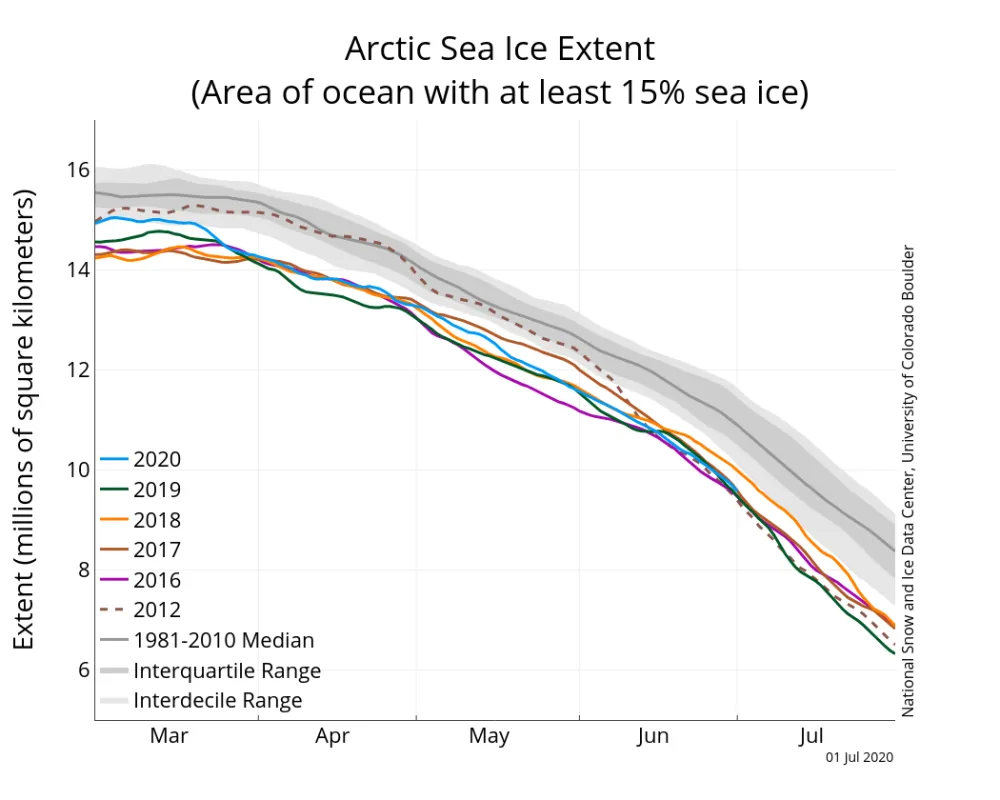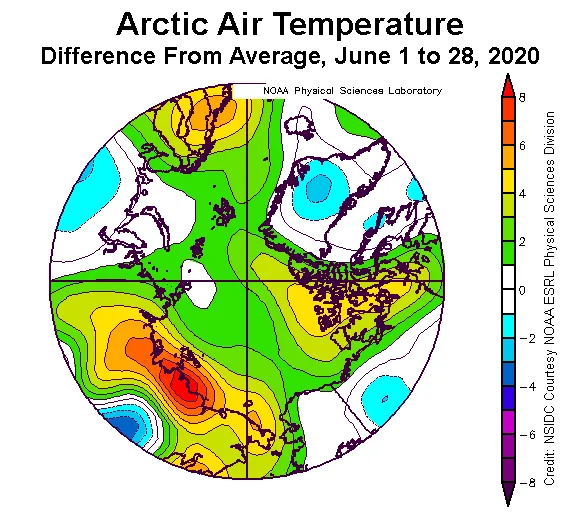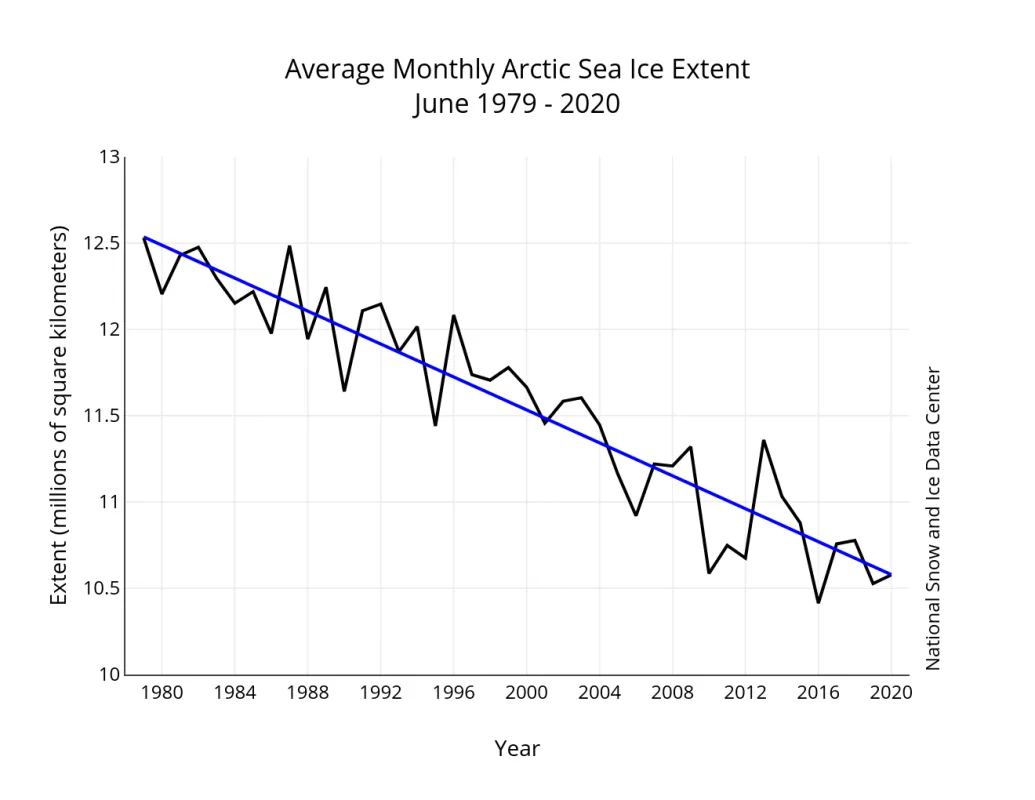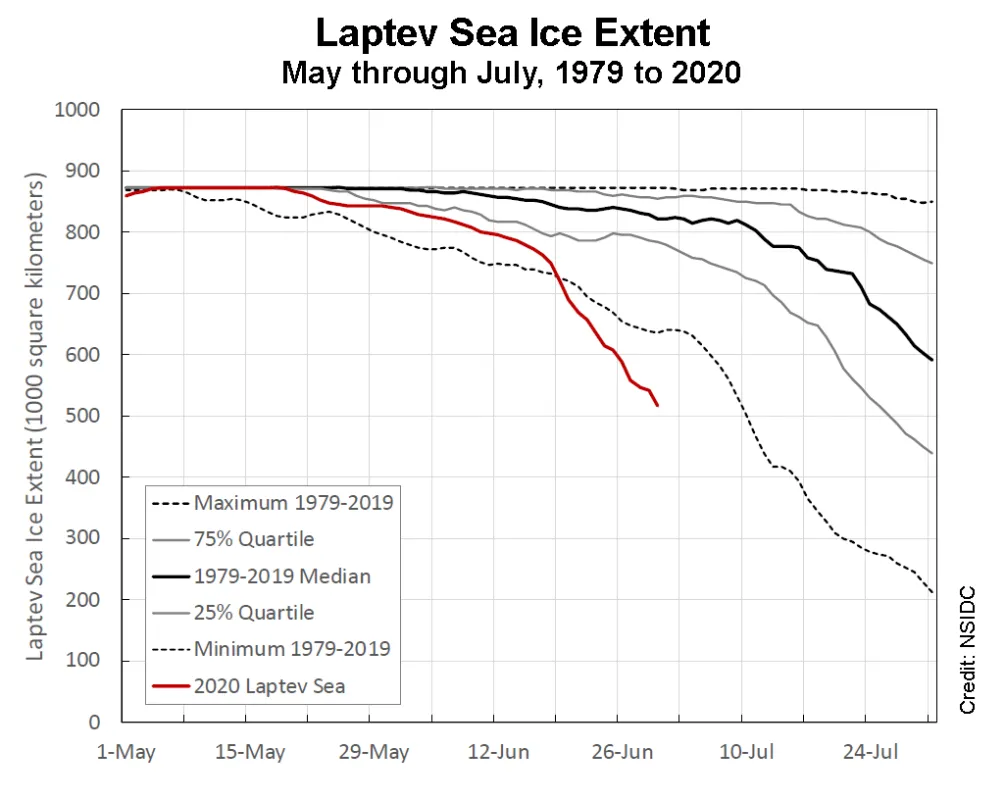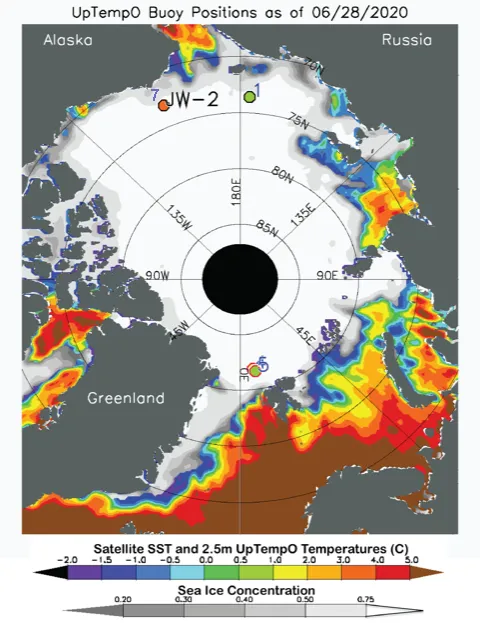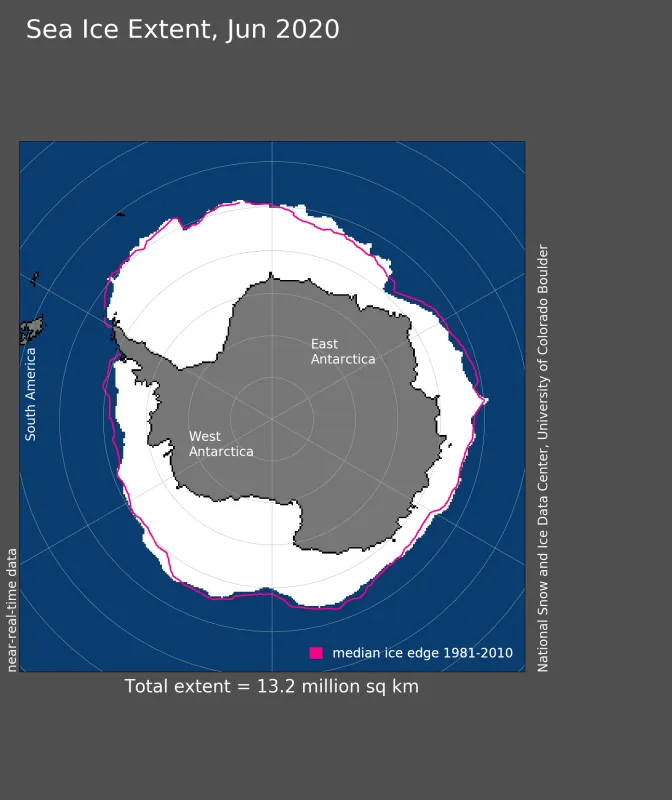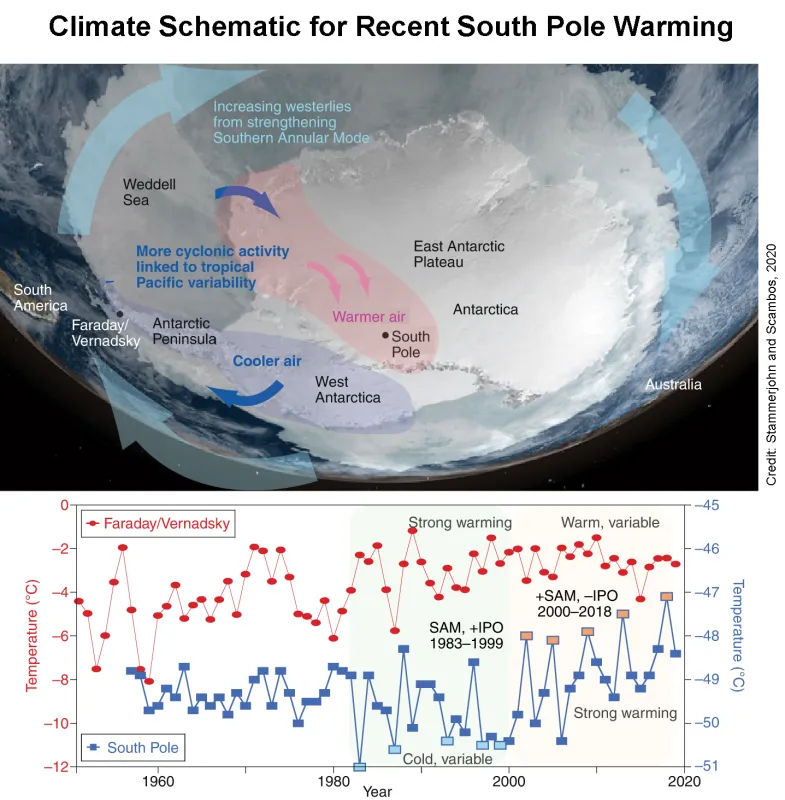The Siberian heat wave continued into June with a record high temperature in Verkhoyansk, just north of the Arctic Circle. The heat also affected the Laptev Sea, where ice extent dropped to a record low for this time of year. Sea ice extent was low overall in the Arctic Ocean, though not at record levels. Late June into early July is the period of most rapid ice loss in the Arctic.
Overview of conditions
June 2020 sea ice extent averaged 10.58 million square kilometers (4.08 million square miles), placing it at third lowest in the satellite record for the month. This was 170,000 square kilometers (65,600 square miles) above the record low set in 2016. Ice loss during June was particularly pronounced in the Kara and Laptev Seas, where extent was well below average. In other areas of the Arctic Ocean, extents were near or slightly below average. Since June 19, sea ice extent in the Laptev Sea has been at a record low for this time of year.
Conditions in context
Through the month, sea ice extent declined by an average of 64,300 square kilometers (40,000 square miles) per day—about 20 percent faster than the 1981 to 2010 average (Figure 2a).
Air temperatures at the 925 mb level (about 2,500 feet above sea level) were 1 to 4 degrees Celsius (2 to 7 degrees Fahrenheit) above average over most of the Arctic Ocean (Figure 2b). Along the Siberian coast of the eastern Laptev Sea, temperatures were 8 degrees Celsius (14 degrees Fahrenheit) above average. After persisting in a winter-long strong positive phase, the Arctic Oscillation has been in a mostly neutral phase since early May.
June 2020 compared to previous years
Through 2020, the linear rate of decline for June sea ice extent is 4.06 percent per decade, which corresponds to 47,700 square kilometers (18,400 square miles) per year, about twice the size of the state of Vermont. The cumulative June ice loss over the 42-year satellite record is 1.96 million square kilometers (757,000 square miles), based on the difference in linear trend values in 2020 and 1979. This is about 12 percent larger than the state of Alaska.
Record set in the Laptev Sea
As noted above, northern Siberia and the Laptev Sea have seen particularly high temperatures compared to average. This contributed to early ice loss in the Laptev Sea. The strongly positive phase of the Arctic Oscillation (AO) over winter likely also played a role; studies have shown that strong offshore motion of the sea ice along the coast of Siberia during the positive AO fosters new ice growth, which is thinner and easier to melt out once summer arrives. Sea ice extent in the Laptev Sea was at record low from June 19 through the end of the month. With the early opening of the Laptev Sea, ocean sea surface temperatures (SST) have already risen up to 4 degrees Celsius (7 degrees Fahrenheit) above freezing, according to NOAA SST data provided by the Upper layer Temperature o the Polar Oceans (UpTemp0) buoy site (Figure 4b). River runoff may also be contributing to the warm surface waters in the region.
News from the South Pole
Antarctic sea ice extent tracked slightly below the 1981 to 2010 average extent for the month of June, as it has for all but a few days since August 2016. Areas of below average ice extent are west of Enderby Land and the Bellingshausen Sea. Ice growth during the month was near average, and ice extent increased primarily in the eastern Weddell Sea, Ross Sea, and Bellingshausen Sea, as winter growth continued rapidly towards the maximum, which generally occurs in early October. An indentation in the sea ice edge in the Cosmonaut Sea region—near 50 degrees E longitude—suggests that a polynya may form there in July or August as the ice edge advances outward. At this time, there is no indication of the Maud Rise Polynya forming near 0 degrees longitude.
Air temperatures at the South Pole are climbing rapidly, according to a recent study led by our colleague, Kyle Clem. During the past 30 years, temperatures there have risen at three times the global average rate—0.6 degrees Celsius (1.1 degree Fahrenheit) per decade at the South Pole versus about 0.2 degrees Celsius per decade (0.4 degrees Fahrenheit) for the recent global average. The warming is tied to atmospheric circulation patterns, the positive trend of westerly winds around Antarctica as represented by the Southern Annular Mode (SAM) and its index, and the Interdecadal Pacific Oscillation (IPO), an El Niño-La Niña-like multi-decadal pattern of surface temperatures in the Pacific. Since the late 1990s, warming in the western tropical Pacific, which is associated with the ‘negative’ or La Niña-like phase of the IPO and climate trends of warmer sea surface temperatures, combined with the long-term trend of faster westerly winds around Antarctica has led to an increase in cyclone activity, i.e. more low- pressure systems, in the Weddell Sea, which tend to drive warm air towards the pole.
An earlier study of 50 years of weather data at South Pole by our colleague Matt Lazzara and others noted the trend towards warming beginning in the mid-1990s, although the larger causes of the warming were not clear at that time.
All of that said, the South Pole is still the South Pole, and that means cold. Following the rapid warming that Clem and his colleagues describe, average annual temperatures set a record in 2018 of -47 degrees Celsius (-53 degrees Fahrenheit).
Further reading
Clem, K. R., R. L. Fogt, J. Turner, B. R. Lintner, G. Marshall, J. R. Miller, and J. A. Renwick. 2020. Record warming at the South Pole during the past three decades. Nature Climate Change. doi:10.1038/s41558-020-0815-z.
Lazzara, M. A., L. M. Keller, T. Markle, and J. Gallagher. 2012. Fifty-year Amundsen–Scott South Pole station surface climatology. Atmospheric Research. doi:10.1016/j.atmosres.2012.06.027.
Stammerjohn, S., and T. Scambos. 2020. Warming reaches the South Pole. Nature Climate Change. doi: 10.1038/s41558-020-0827-8.

